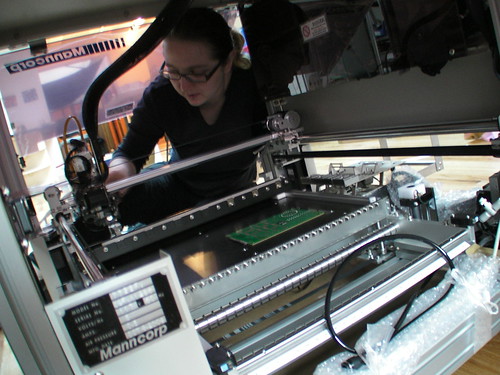I chose Limor Fried, founder and chief engineer of Adafruit Industries, as the subject of my post for Ada Lovelace Day for four reasons:
- Limor is a hardware engineer – one of those bastions of tech in which it’s most important for young girls considering future careers to understand that women can excel. Here’s Limor, making adjustments to the pick and place machine that she uses to manufacture circuit boards for her creative hardware designs.
- Limor is a “complete” entrepreneur, doing whatever it takes to get her business off the ground, from writing software to manage the company’s operations, to hiring and management, to marketing and PR, accounting and finance. When I went to visit her recently in her New York headquarters (a live-work space close to Wall Street), there was so much that reminded me of my own early days at O’Reilly, when I was not just a writer and editor, but also janitor and system administrator, software developer and bookkeeper, marketer, head of sales, and business manager.
My visit filled me with nostalgia – and conviction that I was watching a founder who has everything it takes to take a business from zero to success without any venture financing, relying instead on hard work, a sure sense of an open market niche, and a can-do mindset that would rather just do it than hire someone who’s done it before.
I launched my business in a barn that I had renovated myself. Employees had to tiptoe past my sleeping infant to use the bathroom in the house. Limor too lives onsite, with kitchen and sleeping quarters curtained off from the large room that is at once R&D lab, manufacturing floor, and shipping dock. I wrote the accounting system that my company used to keep track of our finances; Limor has written a system that interfaces a scale with online postage services to minimize shipping costs and maximize delivery time for her customers. I saw early on that the best marketing was evangelization of ideas that matter; Limor too doesn’t sell products so much as she sells a mindset.
- Limor is at the forefront of what Wired identifies as the next industrial revolution, a revolution driven by what I like to call “smart stuff, and dumb stuff made with smart tools.”
Over our years watching the alpha geeks, we’ve concluded that many big technology revolutions don’t start with entrepreneurs, but with hobbyists having fun. Think the Wright Brothers and others who enabled the age of flight, the Homebrew Computer Club that helped birth the personal computer industry, the early web sites that were built with no expectation of financial return, the open source developers who wrote code, as Linus Torvalds admitted “just for fun.”
We noticed an upsurge of “hardware hacking” five or six years ago. O’Reilly publishing co-founder Dale Dougherty realized that it was the beginning of something big and launched Make: Magazine in 2005 to celebrate the movement. The magazine took off, and so Dale launched <a href=http://makerfaire.comMakerFaire, an event reminiscent of the old West Coast Computer Faire. Last year’s Maker Faire in San Mateo drew nearly 70,000 people.
At first, the Maker revolution looked simply like a wacky world of invention for the sake of it, for recreation and for learning, or as Dale put it in the tagline for the magazine, “technology on your own time.” But as in prior technology revolutions, there was a larger business opportunity hiding in plain sight. Right on schedule, we’re seeing the next generation of companies emerge from what at first appeared to be just a bunch of hobbyists having fun. Adafruit is in good company, one of a series of new “Maker Pro” businesses.
And they are not just small businesses any more. Open source hardware projects like Android are now in the mainstream of consumer electronics. Every smartphone has dozens of sensors; skills learned in Maker projects are now applicable to mainstream applications.
- Limor has the open source mindset, working constantly to spread knowledge and enable others. In the video below, Limor explains why she shares her designs (as well as showing off a couple of them.)
Limor has worked to document all the tools she uses, to help other would-be Maker businesses to get a head start. This Makezine article provides a good overview; there’s more detail on her LadyAda Wiki. She’s also doing outreach via weekly live video show, Ask An Engineer
The purpose of Ada Lovelace Day is to celebrate women in technology in hope of encouraging more young women to realize what a great, creative field it is, rife with opportunity for self-expression, for community, and for financial success. Limor Fried is showing them how it’s done.

